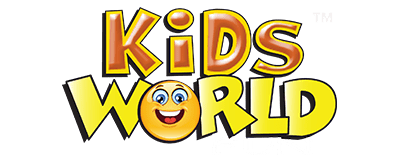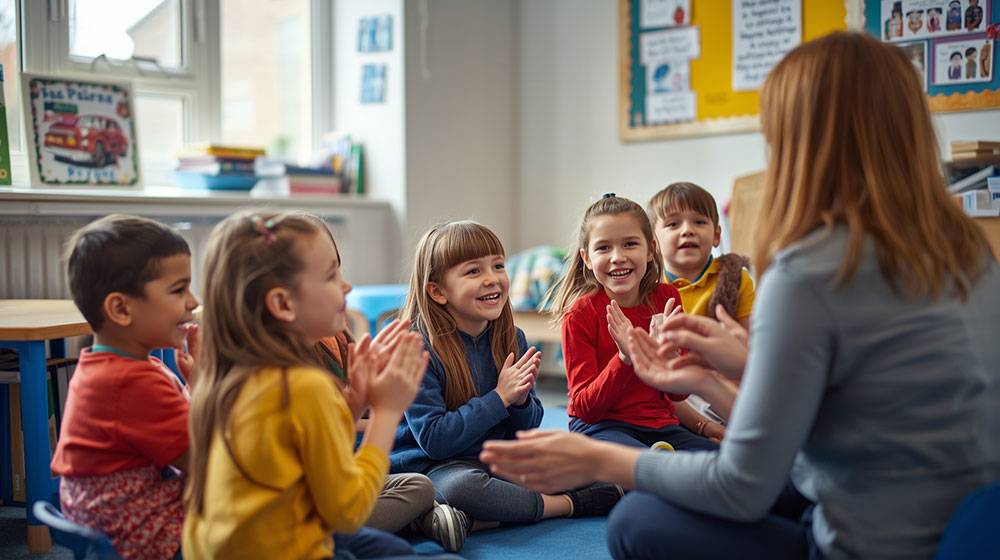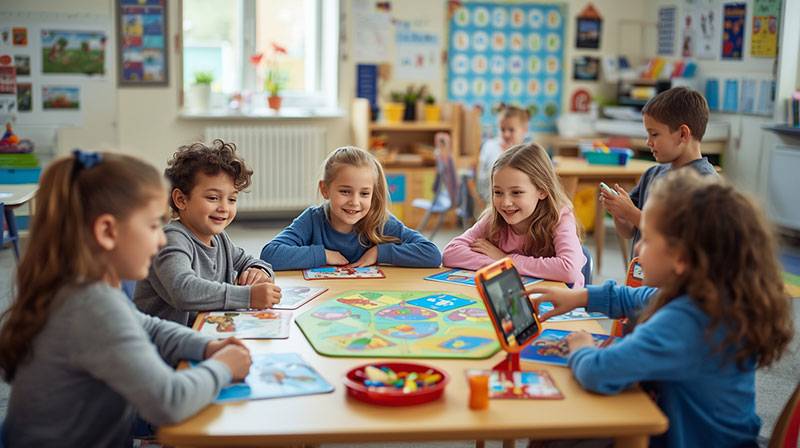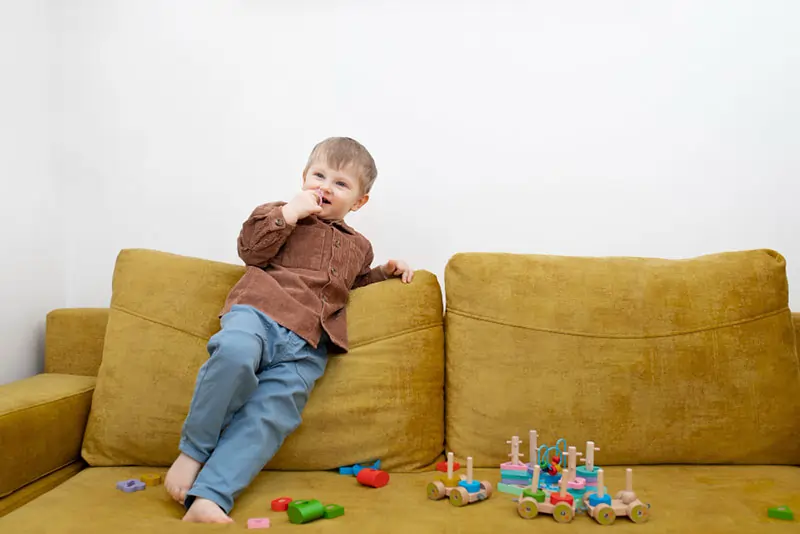The Magic of Rhymes: How Children’s Poetry Enhances Their Language and Creativity
A child’s language, rhythm, and emotional comprehension can all benefit by reading poetry, which is about more than just rhymes. Simple rhymes can convey complex ideas in a memorable and entertaining way, whether they be about generosity, friendship, or nature.
Introduction: The Significance of Poetry for Children
Being a witness to a three-year-old’s first recitation of “Twinkle, Twinkle, Little Star” is an enchanting experience. Their expression brightens up with each rhyme, even as they fumble over words and mix up lines. Poems have a magical effect like that.
Poems are “educational,” but kids don’t care. To them, it simply sounds wonderful. The beat is infectious. Rhymes are memorable. They laugh at the ridiculous phrases. Something more significant is occurring while they enjoy themselves—they are gaining an understanding of the mechanics of language.
Words can move to the beat of poetry. Patterns are formed by those noises. The power of words and rhythm to create vivid imagery. A young reader who enjoys Dr. Seuss isn’t necessarily working on their phonemic awareness or expanding their vocabulary. Just hearing “One fish, two fish, red fish, blue fish” rolled from their tongues is enough to make them happy. Regardless, the learning takes place.
This is an illustration of a child’s imagination blossoming via poetry, set against a background of floating letters, stars, and rhyming words such as cat-hat, sun-fun, moon-tune.
That is the significance of poetry. Education is subtly woven into the entertainment. For some reason, children have an innate ability to recall lengthy poems. With as much zeal, try memorization of a paragraph from a history textbook. Best of luck.
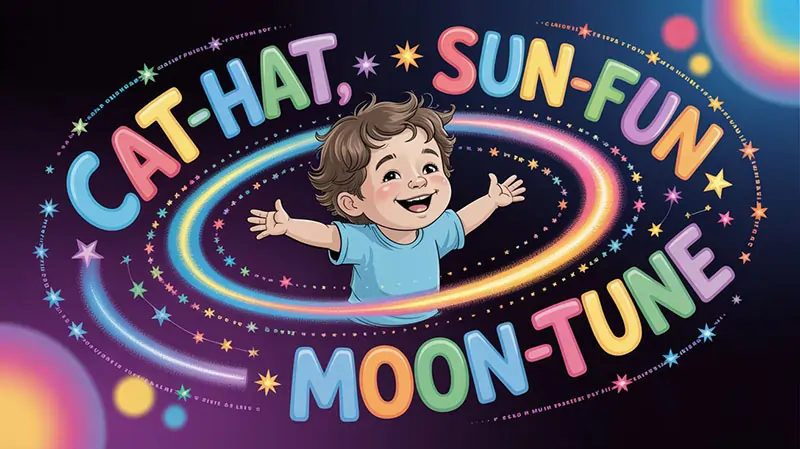
The Advantages of Poetry Reading and Writing
Poetry is more powerful than most people give it credit for. The ones you learned as a kid, the nursery rhymes? Plus, they were good for your brain development.
Advantages of Teaching Children Poetry
| Skill Area | How Poetry Helps | Example |
| Language & Vocabulary | Expands word knowledge and pronunciation. | “Hickory Dickory Dock” introduces rhythm and timing. |
| Memory & Concentration | Repetition of rhymes aids memory retention. | Kids recall lines from nursery rhymes easily. |
| Creativity & Imagination | Encourages visual thinking and storytelling. | Imagining what a “talking moon” might say. |
| Emotional Expression | Helps children express feelings safely. | Writing about happiness or fear through rhymes. |
| Listening & Rhythm | Builds musical sense and attention. | Clapping to rhyme patterns or beats. |
What’s intriguing is that children who read poetry often tend to have better reading abilities in general. Poetry enables students to focus on the *how* of words rather than only their meaning, which is why it should be read alongside other forms of literature. They become cognizant of that fact in all of their reading thereafter.

Various Forms of Poetry for Children
Every poetry has its own unique rhythm. Poetry has rules, but they are designed to be experimented with. Introducing children to diverse styles helps them realize this.
| Type of Poem | Description | Example |
| Rhyming Poems | Words at the end of lines sound alike; great for beginners. | “The cat sat on the mat.” |
| Narrative Poems | Tell a story using rhythm and characters. | “The Owl and the Pussycat” by Edward Lear. |
| Acrostic Poems | Each line starts with a letter of a word to spell it out. | Smile, Under the sky, Never hide, Shine! |
| Limericks | Short, humorous five-line poems with a catchy rhythm. | “There once was a boy from Peru…” |
| Haiku | 3-line poems focusing on nature and simplicity (5-7-5 syllables). | Sunlight on the pond, / Frogs jump into the water— / Ripples disappear. |
Kids frequently find out which ones they like best. Some people really like acrostics because of the structure they offer. For some, the freedom to let their words flow is more enjoyable in free-form rhyming. Okay with me. Permit them to discover what interests them.
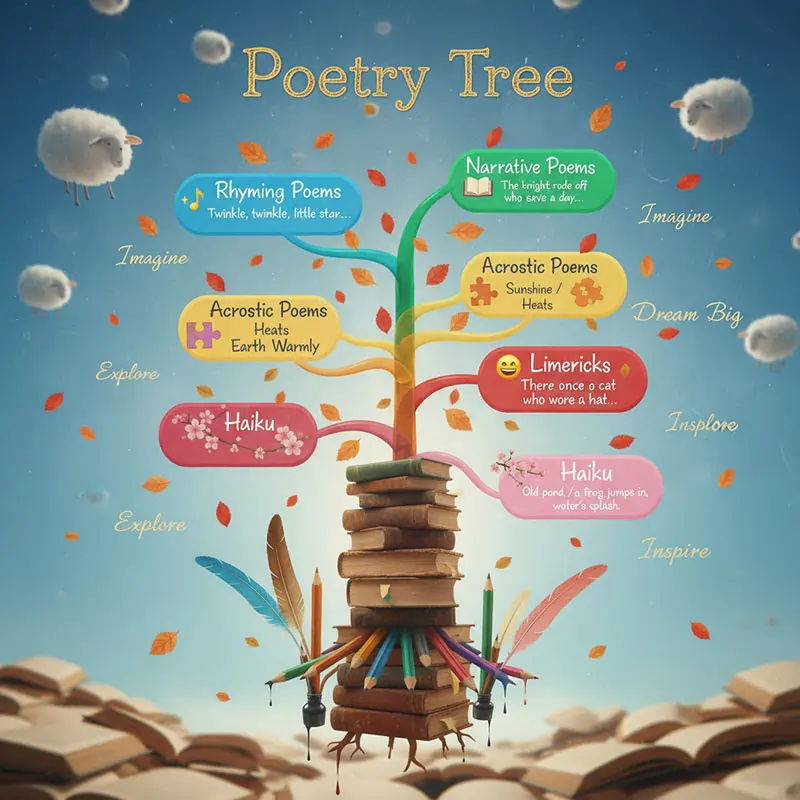
How to Introduce Poetry to Young Readers
The worst approach of presenting poetry? “Today we’re going to study poetry.” Prompt complaints. Optimal approach? Get down to reading it already; there’s no need to be dramatic.
1. Begin with Songs for Young Children
These poetry serve as introductions to more advanced literary works. Their shortness and catchiness make them well-known among children. Children acquire rhythm and pattern through songs like “Humpty Dumpty” and “Baa Baa Black Sheep” without even realizing it.
2. Use Visuals and Actions
Moving poetry is more effective. Carry on a climbing act while listening to “The Itsy Bitsy Spider”. Perform rain dance moves. Bring the tale to life. In addition to what they hear, children recall their actions.
3. Enjoy a Shared Reading Experience
Heard poetry is essential. Half of the enchantment is lost when you read silently. Everything that comes to life when spoken out loud—the rhythm, the rhyme, the flow. Reading aloud relieves stress as well. Make a mess of words? Get back up and try again.
4. Discover Rhyme and Sound Games
Make it a game. “What rhymes with cat?” Then, make the children yell out any and all words that come to mind. “Hat! Bat! Mat! Fat! Sat! Rat!” There may be some paraphrases. It’s alright; the important thing is that they are exploring sound.
5. Establish a Spot for Poetry
Make room for it. Imaginative art materials, colorful novels, and rhyme cards. Bring people in. When poetry is housed in its own designated area, children view it as an important cultural resource.

Notable Children’s Poets and Their Works
There are poets who get the way children think. They have a way with words that tap into kids’ natural curiosity and sense of fun.
| Poet | Famous Work | What Kids Learn |
| Dr. Seuss | The Cat in the Hat | Fun with language and imagination. |
| Shel Silverstein | Where the Sidewalk Ends | Creativity and humor in everyday life. |
| A.A. Milne | Now We Are Six | Childhood curiosity and self-discovery. |
| Robert Louis Stevenson | A Child’s Garden of Verses | Observing nature and daily experiences. |
| Jack Prelutsky | A Pizza the Size of the Sun | Wordplay and laughter through poetry. |
Poets like these know that kids value entertainment more than education. While kids are giggling at silly situations or making up fantastical ideas, the lesson is sneaking in.
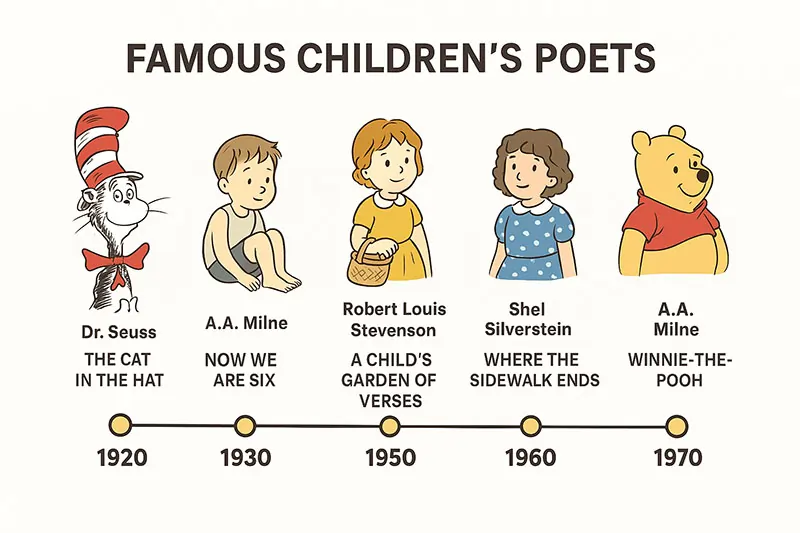
Fun Classroom and Home Poetry Activities
When poetry is transformed into a game, it loses its threatening nature. Let me tell you what works with children:
1. Hunt for Rhymes
Pick out several adjectives like “star,” “book,” and “train.” Put two minutes on the timer. Children should look for words that rhyme with each other. Raises the stakes quickly. Claiming to “hate poetry” can cause a child to develop an unhealthy obsession with winning.
2. Collage of Poetry
Take text and images from magazines and cut them out. Turn them into poems of your own creation. No need to rush the writing process; simply repurpose words to create new meanings. At times, the outcomes are quite profound.
3. Create a Poem Illustration
Have them imagine something after reading a poem. Their interpretations of the phrases are shown through their drawings, which frequently surprise you. The results demonstrate that there is no universally accepted “right” approach to analyzing poetry.
4. Poetry Performance
Little “Poetry Jam” where children act out their favorite poems with costumes and props. Performing someone else’s words instead of their own is a great way for shy children to shock everyone.
5. A Walk Through Nature in Haiku
Let the kids play outside. Take a stroll. Birds, flowers, clouds, and strange creatures are all good subjects for haiku. Gets people to stop and take in their environment instead than merely going through the motions.
6. A Game of Passing the Poem
The children take turns writing a line before passing the paper on. What came out of it all? Typically comic mayhem, sometimes unintentional genius. Regardless, there is much laughter and writing.
| Age | Activity | Focus |
| 3–5 | Rhyme Hunt | Sound Recognition |
| 6–8 | Illustrate a Poem | Visualization |
| 9–12 | Nature Haiku | Creativity & Observation |
| 12+ | Poetry Jam | Confidence & Expression |
Tips for Writing Your Own Kids’ Poems
What most discourages children from composing poetry? They insist that it must be of high quality. That is incorrect. It ought to be light-hearted and truthful. It’s done.
✨ Suggestions for Creative Writing:
- Get it Off the Ground with Sound— Consider rhyming pairs (cat-hat, sun-fun) and construct a short narrative that links them. “The cat wore a hat in the sun for fun.” Task completed. It is poetic.
- Make Sense of Everything — Name the senses you’re using: sight, sound, touch, smell, and taste. When it comes to children, concrete details always win out over abstract ideas.
- Make It Engaging and Concise — Say a lot with just four lines. No child should ever feel that a poem’s length determines its significance.
- Experiment with Patterns — (“I see a bee, I see a tree, I see a boat out at sea…”) or ABC rhymes are two possibilities. Writing becomes easier with patterns.
- Incorporate Feelings — Find out “How does this make me feel?” Allow emotions to dictate the words you use. Although “happy” works, “bouncy like a kangaroo” is vastly superior.
- Paint Your Writing — Complement each poem with a picture. This link between words and pictures is very important for children who learn best visually.
Poem writing ought to be an enjoyable experience, not a chore, because it involves experimenting with words. It should be loose. Rejoice in unusual word choices. Mistakes are funny. That is the path to original thought.
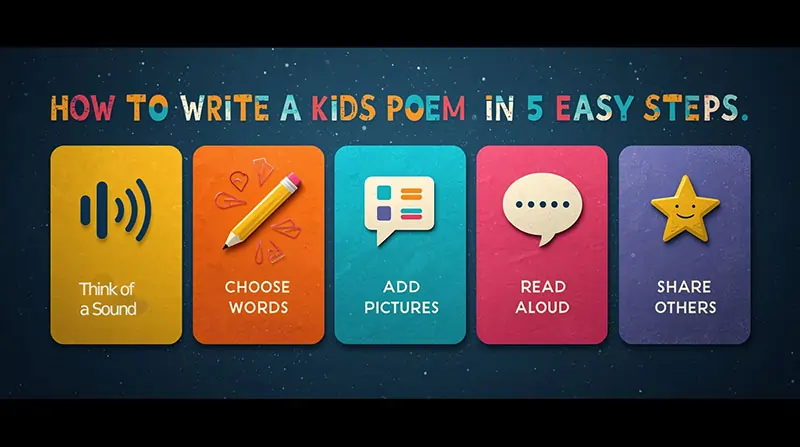
📄A Printable Poetry Worksheet
Rather than only contemplating writing, here is a simple worksheet idea to encourage children to put pen to paper:
| Activity | Instructions | Example |
| Rhyme Match | Match the word to its rhyming pair. | Sun → Fun |
| Acrostic Poem | Write a poem using your name. | J – Joyful A – Adventurous Y – Young at heart! |
| Draw & Write | Draw your favorite animal and write a 4-line poem about it. | “My little cat / sleeps on my mat / dreams of fish / and naps like that.” |
| Limerick Time! | Write a funny 5-line story with rhythm. | “There once was a dog from Kent…” |
❓ Poetry Lessons for Children: Frequently Asked Questions
Q1. At what age should children start learning poems?
Kids can start as early as age two or three with nursery rhymes. As they grow, introduce longer, themed poems gradually.
Q2. Are short rhymes better than long poems?
Yes! Short rhymes are easier for young children to memorize and repeat, building early confidence in reading.
Q3. How can poetry help with reading skills?
Poems improve phonemic awareness—children learn to recognize patterns in sounds, which strengthens reading fluency.
Q4. What’s the difference between rhymes and poems?
All rhymes are poems, but not all poems rhyme! Some poems use rhythm or imagery instead of rhyme.
Q5. Can poetry be integrated with other subjects?
Absolutely. You can write science poems, math rhymes, or nature-inspired verses to make subjects fun and memorable.
Conclusion: Incorporating Poetry into Everyday Activities
Poems are a fun and easy way to incorporate learning, humor, and joy into children’s lives. Children who read poetry on a daily basis cultivate a lifelong appreciation for language, rhythm, and imagination.
Kids learn that language is dynamic and theirs to play with through poetry, whether it’s in the form of bedtime rhymes, school presentations, or humorous verses created with pals.
According to Robert Frost, “A poem begins as a lump in the throat, a sense of wrong, a homesickness, a lovesickness.” Even if they don’t put it into words, kids definitely feel it. Poems let youngsters express emotions for which they don’t yet have words.
As a result, keep in mind that every rhyme is a small spark that lights up creativity and learning the next time you read or write with children. Plus, those embers? Even after childhood is over, they remain illuminated.
